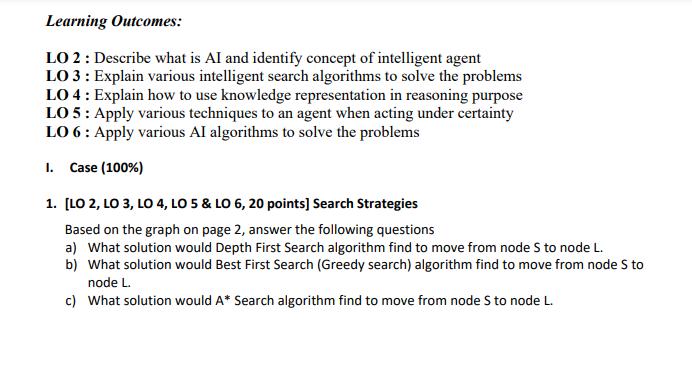Answered step by step
Verified Expert Solution
Question
1 Approved Answer
Learning Outcomes: LO 2: Describe what is AI and identify concept of intelligent agent LO 3: Explain various intelligent search algorithms to solve the



![4. [LO 2, LO 3, LO 4, LO 5 & LO 6, 20 points] Hidden Markov Model Given a hidden Markov Model (HMM) diagram](https://dsd5zvtm8ll6.cloudfront.net/si.experts.images/questions/2022/06/62bc20d0c8fc5_Screenshot460.png)



Learning Outcomes: LO 2: Describe what is AI and identify concept of intelligent agent LO 3: Explain various intelligent search algorithms to solve the problems LO 4: Explain how to use knowledge representation in reasoning purpose LO 5: Apply various techniques to an agent when acting under certainty LO 6: Apply various AI algorithms to solve the problems 1. Case (100%) 1. [LO 2, LO 3, LO 4, LO 5 & LO 6, 20 points] Search Strategies Based on the graph on page 2, answer the following questions a) What solution would Depth First Search algorithm find to move from node S to node L. b) What solution would Best First Search (Greedy search) algorithm find to move from node S to node L. c) What solution would A* Search algorithm find to move from node S to node L. 20 10 A 12 D 13 b) All professors are people. c) Ani is the dean. 12 12 E 10 F K d) All Deans are professors. e) All professors consider the dean a friend or don't know him. f) Everyone is a friend of someone. g) People only criticize people that are not their friends. h) Lucy criticized Ani. Prove that: Ani is not Andi's friend. H 2. [LO 2, LO 3, LO 4, LO 5 & LO 6, 20 points] Inference using First-Order Logic Suppose you are given some facts in First-Order Logics: a) Andi is a professor 3. [LO 2, LO 3, LO 4, LO 5 & LO 6, 20 points] Bayesian Network The 3rd problem is on the next page I 13 L P(A) 0.20 P(-A) 0.80 AB PIC) P(C) TT 0.55 0.45 TF 0.50 0.50 FT 0.45 0.55 FF 0.10 0.90 P(B) P(-8) 0.40 0.60 E P(F) PF) T 0.70 0.30 F 0.20 0.80 Please compute the following probabilities: a) Prob(F,E,C,D,A,B) b) Prob(F,E,C,D, A, B) c) Prob(CB) d) Prob(CIA) B P(D) P(-D) T 0.60 0.40 F 0.55 0.45 CDPE) P(-E) 0.70 0.30 TT + TF 0.50 0.50 + == FT FF 0.20 0.80 0.45 0.55 4. [LO 2, LO 3, LO 4, LO 5 & LO 6, 20 points] Hidden Markov Model Given a hidden Markov Model (HMM) diagram in Figure 2 to represent weather in Jakarta in the past three months. The diagram in Figure 2 shows the process of predicting whether someone will be walking, shopping, or cleaning on a particular day based on whether the day is rainy or sunny. In the diagram, two hidden states are rainy and sunny; while the observed states (activities during corresponding weather) are shopping, walking, or cleaning. Based on observation, someone has the following activity sequence: shop, walk, and clean. What is the most likely weather (the hidden states: Rainy or Sunny) sequence, given such activity sequence. Answer this question using Viterbi algorithm and draw weather hidden states sequence using the Trellis diagram. Hint: For the Viterbi algorithm and the Trellis diagram you can refer to the following book: Stuart Russell, Peter Norvig. 2010. Artificial Intelligence: A Modern Approach, 2nd edition, Pearson Education. New Jersey, ISBN:9780132071482 (see Figure 15.5, p. 548). 0.5 Walk 0.3 Rainy 0.4 0.3 Start 0.5 Shop 0.7 Sunny Figure 2. The Hidden Markov Diagram 0.7 Clean 5. [LO 2, LO 3, LO 4, LO 5 & LO 6, 20 points] Fuzzy Logics Consider the following three simple rules to represent fuzzy relationship between food quality and service in a restaurant as input variables and tip amount as output variables. 1) If the food is bad OR the service is poor, then the tip will be low 2) If the service is acceptable, then the tip will be medium 3) If the food is great OR the service is amazing, then the tip will be high. Given the membership functions illustrated in Figure 1 and 2 as follows. 10 0.8 06 0.4 0.2 0.0 0 10 0.8 0.6 0.4 0.2 0.0 Food quality Service quality Bad Decent Great Poor Acceptable Amazing Figure 1. Food Quality and Service Membership Functions 1.0. 08 06 04 02 00 10 1) Food quality was 6.0, and 2) Service was 8.0 Tip amount 15 Figure 2. Tip Membership Functions Low Medium High FM-BINUS-AA-FPU-78/V2RO Using the clipped center of gravity method, compute the tip amount based on the following circumstances:
Step by Step Solution
★★★★★
3.34 Rating (154 Votes )
There are 3 Steps involved in it
Step: 1
1 Search Strategies a Depth First Search algorithm The DFS algorithm starts at the root node S and explores as far as possible along each branch before backtracking The algorithm will find the followi...
Get Instant Access to Expert-Tailored Solutions
See step-by-step solutions with expert insights and AI powered tools for academic success
Step: 2

Step: 3

Ace Your Homework with AI
Get the answers you need in no time with our AI-driven, step-by-step assistance
Get Started


